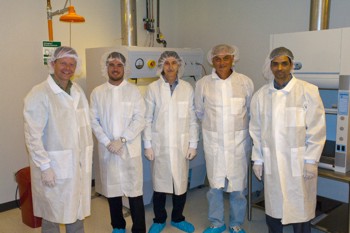Start-Up Rolith Tackles Industrial-Scale Nanostructured Coatings
Start-Up Rolith Tackles Industrial-Scale Nanostructured Coatings
New Technology has Applications in Solar Cells, "Smart Glass," Displays, and More
With its arrival in Hacienda, Rolith, Inc., is poised to bring a significant advance to the fast-growing field of nanocoatings. Founded in 2008, the start-up took a major step forward when it moved from its original office in Dublin to new quarters at 5880 W. Las Positas Boulevard in August. A spacious new lab accommodates the development of Rolith's proprietary technology, which will enable a host of next-generation commercial and consumer products like high efficiency 3D solar cells, "smart glass," advanced TV and computer displays, and high capacity batteries, among other products.
Rolith's advanced nanostructured coatings can be used to modify properties of existing products or design completely new types of products with extraordinary features. For example, "smart glass" has a structure on its surface that can make it function in a designated way. On a building, the material could be used to make windows that are self-cleaning, without the need for any physical or chemical contact. Or it could be designed to redistribute incoming light during the day, reducing the need for electrical lighting. Other options include anti-glare glass that does not reflect any light, or special colorations that do not require dyes or additional materials.
Rolith gets its name from two words that encapsulate its core technology, "rolling" and "lithography," explains the company's CEO/President Boris Kobrin, Ph.D., who has five early-stage companies and 80 published patents to his credit. "We have developed the capability to modify surfaces by patterning them using nanolithography. On a given surface we can fabricate a structure having very small features, such as an array of nanoholes or nanoposts, to create various capabilities for a product, from anti-reflective to anti-glare to self-cleaning properties, and then scale the process to large areas."
That ability to scale is a key breakthrough. Typically micro- and nanolithography have been used only in the computer chip industry, on a very small area limited by wafer size, Kobrin relates. Rolith has invented a way to apply the technology to much larger areas. "So far, we have demonstrated the capability to manufacture nanostructures on glass plates with a size up to a 12-inch by 12-inch square."
A progression to larger sizes will follow. Next year's prototype is expected to extend up to one meter. The target for 2013 is "to build a production system capable of nanostructuring Gen 5, which is more than one meter. Eventually, our technology will be scalable to Gen 10, up to three meters."
The company's technology road map calls for an initial focus on glass applications, which also includes information displays like those found on TV screens, iPods, and cell phones. In the future are plans to address specific energy generation and storage challenges, such as manufacturing high efficiency nanostructured solar cells and advanced batteries.
Rolith received seed financing in October 2010 and is currently raising series A funding, with the expectation of a November closing. For more information, visit www.rolith.com.
Photo: Rolith's brain trust shows off their new Hacienda clean room.
Also in this issue...
- New RE/MAX Accord Office Emphasizes Confidence in the Housing Market
- Start-Up Rolith Tackles Industrial-Scale Nanostructured Coatings
- Business Bits
- Executive Profile: Ron Bissinger, Aplegen
- Delta Groups Engineering Busy with New Cell Sites
- Visioneer Deepens Sustainability Commitment with "Where There Is a Need" Charitable Program
- City of Pleasanton Services at a Glance
- Hacienda Rolls Out Riiwards.com in Time for Holiday Selling
- Spectrum of Science Offers Special Camps in December and May
- TVHOC's Giving Campaign Emphasizes Link Between Employee Housing, Well-Being
- 1st Annual Foundation Gala
- Hacienda Online!
- Hacienda Index
- Calendar





